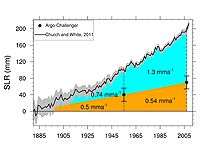Century-old science helps confirm global warming

(Phys.org) —Ocean measurements taken more than 135 years ago during the scientific expedition of HMS Challenger have provided further confirmation of human-produced global warming over the past century.
The researchers also found the thermal expansion of sea water caused by this global warming contributed to around 40 per cent of the total sea level rise seen in tide gauges from 1873 to 1955. The remaining 60 per cent was likely to have come from the melting of ice sheets and glaciers.
"Our research revealed warming of the planet can be clearly detected since 1873 and that our oceans continue to absorb the great majority of this heat," said lead author Dr Will Hobbs, a researcher at the University of Tasmania's Institute for Marine and Antarctic Studies and the Australian Research Council's Centre of Excellence for Climate System Science.
"Currently scientists estimate the oceans absorb more than 90 per cent of the heat trapped by greenhouse gases, and we attribute the global warming to anthropogenic causes."
The Challenger expedition, from 1872-1876, was the world's first global scientific survey of life beneath the ocean surface. Along the way scientists measured ocean temperatures, lowering thermometers hundreds of metres deep on ropes made from Italian hemp during its voyage.
Researchers combined these data with modern observations and used both in state-of-the-art climate models to get a picture of how the world's oceans have changed since the Challenger's voyage.
"The key to this research was to determine the range of uncertainty for the measurements taken by the crew of the Challenger," said study co-author Josh Willis, a climate scientist at NASA's Jet Propulsion Laboratory.
"After we had taken all these uncertainties into account, it became apparent that the rate of warming we saw across the oceans far exceeded the degree of uncertainty around the measurements.
"So, while the uncertainty was large, the warming signal detected was far greater."
Uncertainties around the Challenger's measurements were caused by the limited areas measured during the voyage; the actual depths the thermometers descended to and the likely natural variation in temperature that could occur in each region during the voyage.
To get the most reliable results the researchers used the most conservative estimates after taking into account the maximum possible variation caused by these uncertainties.
"Because we took the most conservative outcome, we are likely to have underestimated the true temperature rise," said Dr Hobbs.
"A simple analysis of our results suggests we may have underestimated the warming by as much as 17 per cent. In fact many of the stations most prone to bias were in the Eastern Pacific - a region showing one of the strongest ocean warming trends - so the true warming may be even larger than that."
In addition to determining the increase in temperatures, the measurements from the Challenger expedition revealed the amount of thermal expansion in sea level rise in the oceans before the 1950s. Prior to this research, climate models offered the only way to estimate the change.
"This research adds yet another suite of compelling data that shows human activity continues to have a dramatic influence on the Earth's climate," said Dr Hobbs.
Provided by University of Tasmania

















